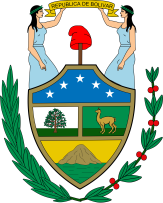Bolivia or not I’m walking on air…
July 20, 2015
-

image courtesy of http://www.flags.net
Bolivia…that one South American country you always forget is there (at least that I do). This is really a shame, aside from being one of the only two that are land-locked, it is named for Simón Bolívar, the rebel and freedom fighter who played a huge role in the independence of so many of the South American countries. He was an interesting guy and yet in the US we are taught very little about him or his namesake land. Let’s change that…
First of all, Bolivia’s coat of arms has an alpaca on it, so, right there, it’s better than everyone else’s. If that wasn’t enough it has a lovely palm tree AND a Papa Smurf hat!!! Although, I think the coat of arms predates the Belgian comic…yea that’s right, the Smurfs are Belgian, it didn’t come up when we did that country and now I kind of regret it…but I digress.
The hat in both instances is actually a Phrygian cap which dates to antiquity. It represents freedom and the pursuit of liberty, so very appropriate for a country named after Señor Freedom Pants. Bolívar is still a polarizing figure due to his political beliefs. Although he admired American Democracy, he believed it would not work in South America. He thought only a president for life with a firm ruling hand could keep the region under control.
During the Spanish colonial period the country was known as Upper Peru. Its history is littered with instability and the loss of territory to other neighboring countries. Over half of the original lands have been lost. Regardless of its current size, it has the second highest natural gas reserves in South America and has a long term agreement to sell to Brazil. They also produce a lot of coca leaves…for medicinal and religious uses of course. The Pope denied taking some recently to help him cope with the altitudes of the capital… La Paz, not Sucre… Sucre is also a capital…it has two capitals… just deal with it. Instead he said that he opted for nice Mate tea…did the Pope lie??? You be the judge!
Tonight we dine on wrapped up little boys…and no, this is not from the Jonathan Swift cookbook. Niños Envueltos is a really tasty, if difficult to assemble, dish. You are basically using swiss steak/cube steak as the wrapper to put around a host of ingredients. If done correctly, it can be a visually stunning dish and very impressive, and even if not, it still tastes great. The one thing I would do next time would be to pound out the beef even thinner, and make sure it has been out of the refrigerator for some to warm up and make the meat more malleable. Well I just ran out of “M”s after that sentence so I think I will call it a day in Bolivia.
Next time we rendezvous in Bosnia and Herzegovina, where I’m sure we’ll have a mouth full no matter what…
Niños Envueltos
3 servings
Ingredients:
6 swiss/cube steaks
1 cup of frozen green peas, defrosted
1 cup carrots, cut into matchsticks
3 eggs, beaten well (mix in a little grated cheese or milk if desired)
1 medium onion (chopped)
2 garlic cloves, minced
1 TBS tomato paste
1 tsp paprika
1 bay leaf
Canola oil
1 cup beef broth
1 cup water
Salt and pepper to taste
——————————————
Directions:
- Cook carrots in pan or microwave until slightly tender, set aside.
- Cut onion in half then slice into quarter inch slices; set aside.
- In a large fry pan cook the beaten eggs. Don’t scramble the eggs, let them cook as one large thin sheet.
- Slice the cooked egg into half inch wide strips; Set aside.
- Season steaks with salt and pepper.
- Top each steak with a layer of each ingredient starting with the egg, then carrots and peas.
- Roll the beef and fillings up into a roll and secure meat with toothpicks to prevent unrolling.
- Brown the beef rolls on all sides in pan with oil.
- In a pot large enough to accommodate all beef rolls, combine onions, garlic, tomato paste, paprika, beef stock, and one cup water; mix well to dissolve the tomato paste.
- Add beef rolls to pot; bring mixture to a boil then reduce heat to low, cover and cook until beef is tender and cooked through.
- Adjust seasoning by adding salt and pepper to taste.
- Turn off heat; remove bay leaf; move beef rolls to a platter.
- Blend remaining liquid and onion mixture with stick blender/food processor/blender until it becomes a smooth sauce.
- Top beef with sauce.


